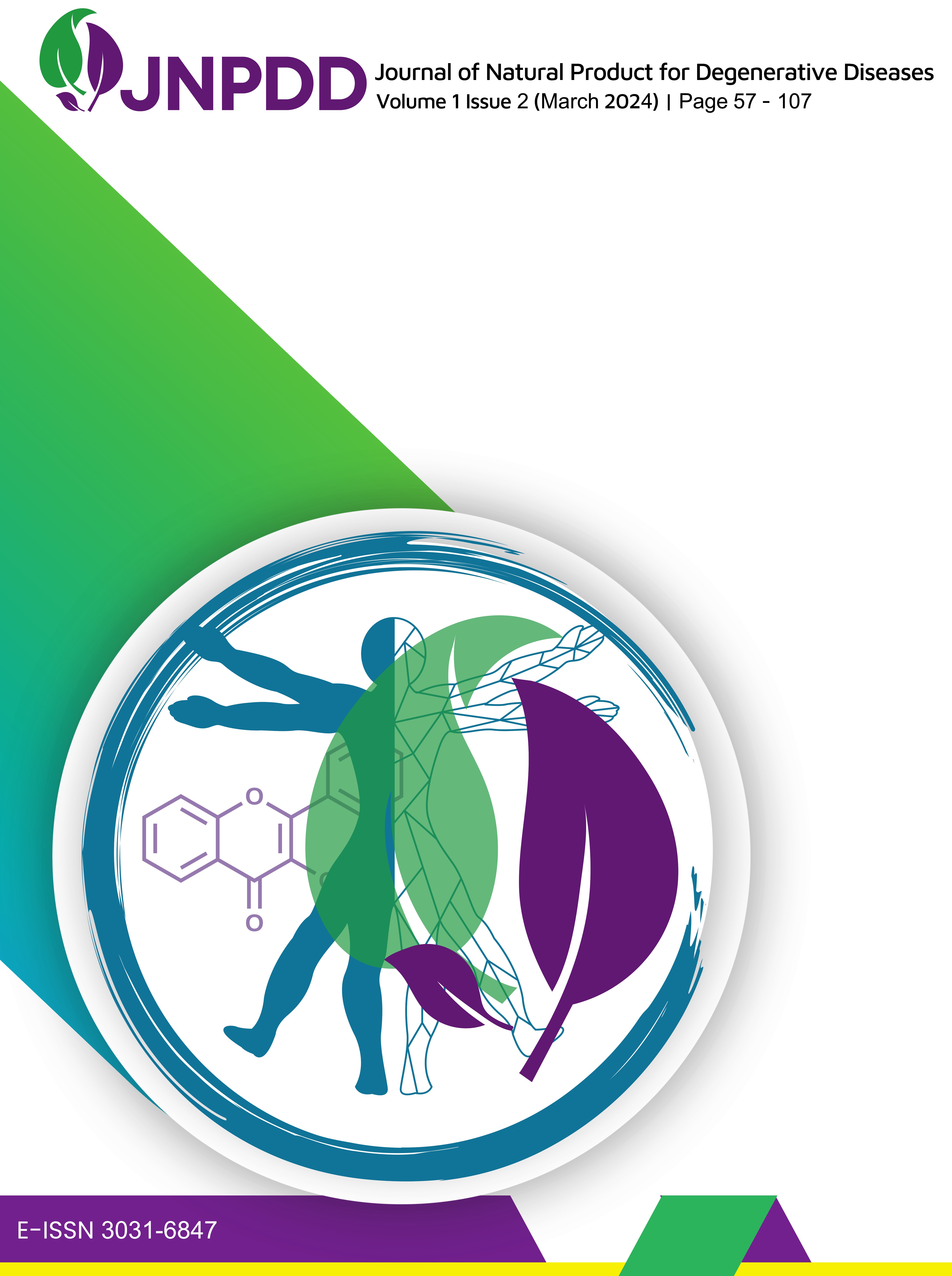Effects of 70% Ethanol Extract of Foeniculum vulgare and Coleus amboinicus as a Potential Diarrhea Treatment Using Intestine Transit Method
Abstract views: 220 | PDF downloads: 171
Abstract
Diarrhea is a condition where the frequency of defecation increases more than three times a day. In underdeveloped nations like Indonesia, diarrhea is a sickness that frequently affects people. Diarrhea can be fatal, causing dehydration and even death if not treated properly. Using alternative treatments like fennel seeds and cumin leaves is one way to treat diarrhea. Fennel seeds and cumin leaves includes secondary tannin metabolites that are effective antidiarrheal agents. Test the antidiarrheal effect of Foeniculum vulgare ethanol extract (FVEE) and Coleus amboinicus ethanol extract (CAEE) using the intestinal transit method on mice was carried out on 9 groups, each group consisting of 5 mice: negative control, Loperamide control, Diapet® control, FVEE and CAEE at doses of 100, 200 and 400 mg/kg. To induce diarrhea through oral administration, castor oil was used in experiments. Four hours following the start of the induction, the treatment group received. They received norit an hour later, and the mice were sacrificed 20 minutes after receiving norit. The intestines were taken out of the mice after they had been dissected, starting from the rectum to the pylorus. Measured the length of the intestine overall and the portion that passed through the norit marker. Calculations were made to determine how much of the gut went by a marker compared to the entire intestine. The results of the study showed that FVEE has an antidiarrheal effect at a level of 100 mg/kg and CAEE has an antidiarrheal effect at a dose of 200 mg/kg.
References
P. dos Santos Negreiros et al., “Antidiarrheal activity of α-terpineol in mice,” Biomed. Pharmacother., vol. 110, no. November 2018, pp. 631–640, 2019, doi: 10.1016/j.biopha.2018.11.131.
M. Smieja and D. M. Goldfarb, “Molecular Detection of Diarrheal Pathogens,” Clin. Microbiol. Newsl., vol. 38, no. 17, pp. 137–145, 2016, doi: 10.1016/j.clinmicnews.2016.08.001.
M. L. de Souza Pessoa et al., “Antifungal activity and antidiarrheal activity via antimotility mechanisms of (-)-fenchone in experimental models,” World J. Gastroenterol., vol. 26, no. 43, pp. 6795–6809, 2020, doi: 10.3748/wjg.v26.i43.6795.
I. G. Domínguez-Vigil, B. D. Mata-Cárdenas, P. C. Esquivel-Ferriño, F. G. Avalos-Alanís, J. Vargas-Villarreal, and M. del R. Camacho-Corona, “Antigiardial Activity of Foeniculum vulgare Hexane Extract and Some of Its Constituents,” Plants, vol. 11, no. 17, pp. 1–7, 2022, doi: 10.3390/plants11172212.
S. B. Badgujar, V. V. Patel, and A. H. Bandivdekar, “Foeniculum vulgare Mill: A review of its botany, phytochemistry, pharmacology, contemporary application, and toxicology,” Biomed Res. Int., vol. 2014, 2014, doi: 10.1155/2014/842674.
I. Sahrial and R. Solfaine, “Effects of Coleus amboinicus L. Essential Oil and Ethanolic Extracts on Planktonic Cells and Biofilm Formation of Microsporum canis Isolated from Feline Dermatophytosis,” Antibiotics, vol. 11, no. 12, 2022, doi: 10.3390/antibiotics11121734.
S. Ślusarczyk et al., “Phytochemical profile and antioxidant activities of coleus amboinicus lour. Cultivated in Indonesia and Poland,” Molecules, vol. 26, no. 10, 2021, doi: 10.3390/molecules26102915.
P. Astuti, S. Sudarsono, K. Nisak, and G. W. Nugroho, “Endophytic fungi isolated from Coleus amboinicus lour exhibited antimicrobial activity,” Adv. Pharm. Bull., vol. 4, no. Suppl 2, pp. 599–605, 2014, doi: 10.5681/apb.2014.088.
R. T. Dewi et al., “Quality control standardization of Indonesian noni fruit (Morinda citrifolia) extract and evaluation of their angiotensin-converting enzyme inhibitory activity,” Pharmacia, vol. 69, no. 3, pp. 709–717, 2022, doi: 10.3897/pharmacia.69.e86854.
A. A. Styawan, A. Putri, and R. Ramadhani Nur Cholifa, “Analisis Kadar Tanin Dari Kelopak Bunga Rosella Merah (Hibiscus Sabdariffa, L.) Secara Permanganometri,” Urecol Journal. Part D Appl. Sci., vol. 1, no. 1, pp. 1–8, 2021, doi: 10.53017/ujas.31.
N. Nurul, G. Septiani, and L. Rahmawati, “Uji Aktivitas Antidiare Ekstrak Etanol Daun Katuk ( Breynia androgyna ( L .)) pada Mencit Putih dengan Metode Transit Intestinal,” J. Ilmu Kefarmasian, vol. 3, no. 2, pp. 331–340, 2022.
M. Fraga-Corral et al., “Technological application of tannin-based extracts,” Molecules, vol. 25, no. 3, pp. 1–27, 2020, doi: 10.3390/molecules25030614.
F. L. Braghiroli, G. Amaral-Labat, A. F. N. Boss, C. Lacoste, and A. Pizzi, “Tannin gels and their carbon derivatives: A review,” Biomolecules, vol. 9, no. 10, 2019, doi: 10.3390/biom9100587.
W. Jing, C. Xiaolan, C. Yu, Q. Feng, and Y. Haifeng, “Pharmacological effects and mechanisms of tannic acid,” Biomed. Pharmacother., vol. 154, no. June, p. 113561, 2022, doi: 10.1016/j.biopha.2022.113561.
K.-T. Chung et al., “Critical Reviews in Food Science and Nutrition Tannins and Human Health: A Review Tannins and Human Health: A Review,” Crit. Rev. Food Sci. Nutr., vol. 386, no. 386, pp. 37–41, 1998, [Online]. Available: http://www.tandfonline.com/loi/bfsn20%5Cnhttp://dx.doi.org/10.1080/10408699891274273%5Cnhttp://%5Cnwww.tandfonline.com/.
M. Camilleri, J. H. Sellin, and K. E. Barrett, “Pathophysiology, Evaluation, and Management of Chronic Watery Diarrhea,” Gastroenterology, vol. 152, no. 3, pp. 515–532, 2017, doi: 10.1053/j.gastro.2016.10.014.Pathophysiology.
L. R. SCHILLER, “Review article: anti‐diarrhoeal pharmacology and therapeutics,” Aliment. Pharmacol. Ther., vol. 9, no. 2, pp. 86–106, 2007, doi: 10.1111/j.1365-2036.1995.tb00358.x.
B. K. Sandhu, J. H. Tripp, D. C. A. Candy, and J. T. Harries, “Loperamide: Studies on its mechanism of action,” Gut, vol. 22, no. 8, pp. 658–662, 1981, doi: 10.1136/gut.22.8.658.
P. E. Wu and D. N. Juurlink, “Clinical Review: Loperamide Toxicity,” Ann. Emerg. Med., vol. 70, no. 2, pp. 245–252, 2017, doi: 10.1016/j.annemergmed.2017.04.008.




